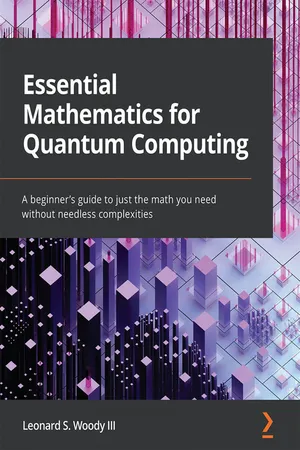
- 252 pages
- English
- ePUB (mobile friendly)
- Available on iOS & Android
Essential Mathematics for Quantum Computing
About this book
Demystify quantum computing by learning the math it is built on
Key Features
- Build a solid mathematical foundation to get started with developing powerful quantum solutions
- Understand linear algebra, calculus, matrices, complex numbers, vector spaces, and other concepts essential for quantum computing
- Learn the math needed to understand how quantum algorithms function
Book Description
Quantum computing is an exciting subject that offers hope to solve the world's most complex problems at a quicker pace. It is being used quite widely in different spheres of technology, including cybersecurity, finance, and many more, but its concepts, such as superposition, are often misunderstood because engineers may not know the math to understand them. This book will teach the requisite math concepts in an intuitive way and connect them to principles in quantum computing.Starting with the most basic of concepts, 2D vectors that are just line segments in space, you'll move on to tackle matrix multiplication using an instinctive method. Linearity is the major theme throughout the book and since quantum mechanics is a linear theory, you'll see how they go hand in hand. As you advance, you'll understand intrinsically what a vector is and how to transform vectors with matrices and operators. You'll also see how complex numbers make their voices heard and understand the probability behind it all.It's all here, in writing you can understand. This is not a stuffy math book with definitions, axioms, theorems, and so on. This book meets you where you're at and guides you to where you need to be for quantum computing. Already know some of this stuff? No problem! The book is componentized, so you can learn just the parts you want. And with tons of exercises and their answers, you'll get all the practice you need.
What you will learn
- Operate on vectors (qubits) with matrices (gates)
- Define linear combinations and linear independence
- Understand vector spaces and their basis sets
- Rotate, reflect, and project vectors with matrices
- Realize the connection between complex numbers and the Bloch sphere
- Determine whether a matrix is invertible and find its eigenvalues
- Probabilistically determine the measurement of a qubit
- Tie it all together with bra-ket notation
Who this book is for
If you want to learn quantum computing but are unsure of the math involved, this book is for you. If you've taken high school math, you'll easily understand the topics covered. And even if you haven't, the book will give you a refresher on topics such as trigonometry, matrices, and vectors. This book will help you gain the confidence to fully understand quantum computation without losing you in the process!
]]>
Frequently asked questions
- Essential is ideal for learners and professionals who enjoy exploring a wide range of subjects. Access the Essential Library with 800,000+ trusted titles and best-sellers across business, personal growth, and the humanities. Includes unlimited reading time and Standard Read Aloud voice.
- Complete: Perfect for advanced learners and researchers needing full, unrestricted access. Unlock 1.4M+ books across hundreds of subjects, including academic and specialized titles. The Complete Plan also includes advanced features like Premium Read Aloud and Research Assistant.
Please note we cannot support devices running on iOS 13 and Android 7 or earlier. Learn more about using the app.
Information
Section 1: Introduction
- Chapter 1, Superposition with Euclid
- Chapter 2, The Matrix
Chapter 1: Superposition with Euclid
- Vectors
- Linear combinations
- Superposition
Vectors



Vector addition

Table of contents
- Essential Mathematics for Quantum Computing
- Acknowledgements
- Preface
- Section 1: Introduction
- Chapter 1: Superposition with Euclid
- Chapter 2: The Matrix
- Section 2: Elementary Linear Algebra
- Chapter 3: Foundations
- Chapter 4: Vector Spaces
- Chapter 5: Using Matrices to Transform Space
- Section 3: Adding Complexity
- Chapter 6: Complex Numbers
- Chapter 7: EigenStuff
- Chapter 8: Our Space in the Universe
- Chapter 9: Advanced Concepts
- Section 4: Appendices
- Appendix 1: Bra–ket Notation
- Appendix 2: Sigma Notation
- Appendix 3: Trigonometry
- Appendix 4: Probability
- Appendix 5: References
- Other Books You May Enjoy